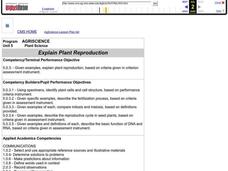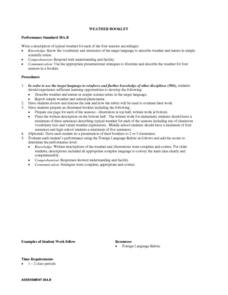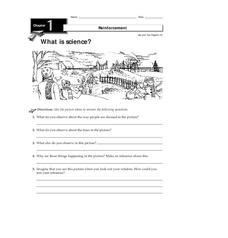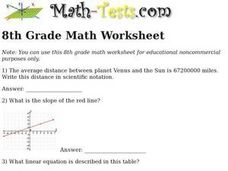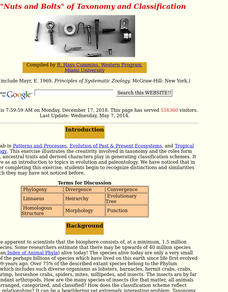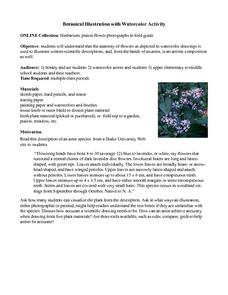Desert Museum
Daisy Ecology
Here's a fine lesson that combines poetry with life sciences. Learners carefully listen to a poem that's all about a food chain. As the poem is read, learners name the producer, the herbivore, the carnivore, and the omnivore. Lots of...
Curated OER
Plant Reproduction
Students plant seeds in order to investigate and explore the questions: "How do seed companies develop varieties of plants?" and "What is the ideal plant?" Students will study related vocabulary and sketch seeds as they emerge. Students...
Curated OER
A Photosynthesis Timeline
Science learners discover that scientific advancements come in increments. Beginning as an idea, changes and developments are influenced by available resources and current societal values. As an example, pupils examine the conclusions...
Curated OER
Sort the Compost Bin
Young scholars discover what compost is. In this composting lesson, students view a sample of a compost bin and define what the purpose of compost is. Young scholars discuss what the compost bin consists of and sort the compost bin into...
Curated OER
Composition in Journals
Carlos Fuentes’s The Diary of Frida Kahlo: An Intimate Self-Portrait and Jaspre Bark’s Journal of Inventions: Leondardo da Vince serve as models for an assignment that asks class members to create a personal journal they will use...
Virginia Polytechnic Institute and State University
Lesson Plan: Omelet Cooking Principles
Although designed for a foods lab, the information in this resource might be just the thing for your own recipe notebook. Illustrated, step-by-step directions for making the perfect omelet, egg-citing puzzles, games, and even...
Virginia Department of Education
Historical Models of Atoms
What does the past have to do with today? Young scientists find that answer as they learn more about past chemists and their significant contributions to the field. Pupils use the Internet to research historical figures and create a...
NOAA
Wet Maps
How do oceanographers make maps under water? Junior explorers discover the technologies and processes involved in creating bathymetric maps in part three of a five-part series designed for fifth- and sixth-grade pupils. The lesson plan...
American Chemical Society
What Makes it Rain?
Clouds come alive when curious minds create rain in an action-packed activity. Scholars view a video of rain and analyze an image of water uses to generate a class discussion leading into a hands-on exploration. Using a set of...
Curated OER
Weather Booklet
Students write a description of typical weather for each of the four seasons. They use the vocabulary and structures of the target language to describe weather and nature in simple scientific terms. Students use the appropriate...
Curated OER
Motion in Fluids
Young scholars explore physical science by participating in a science activity. In this liquids lesson, students discuss how fluids can be affected by motion unlike solids. Young scholars define other scientific vocabulary terms and...
Curated OER
Time For A Change: Illustrated Plates
Students create illustrated plastic plate designs depicting a physical, chemical, or biological change of some kind after investigating the artwork of porcelain artist Kataro Shirayamadani.
Curated OER
The Rock Cycle
In this rock cycle worksheet, students copy the table illustrated for data and observations of rock samples. Then they examine the rock samples observing the characteristics and the arrangement of grains in each. Students then record...
Curated OER
What is Science?
In this scientific observations worksheet, students study an illustration and then complete 5 short answer questions about what they observe happening in the picture.
Curated OER
Blue Planet: Open Ocean
Young scholars research facts about animal species. In this ocean lesson students view a video, prepare illustrated cards and create a food-web display.
Curated OER
The Rain Cycle
Third graders draw the rain cycle. In this rain cycle lesson plan the students listen to the story The Legend of the Bluebonnet by Tommie DePola. As they listen to the story they sketch what is happening. The students write a sentence...
Curated OER
Are You the Bug or the Windshield
A fun slide show which illustrates different size bugs hitting car windshields. Your junior highers should be amused while they learn the relationships between mass, velocity, and force of an impact. Scientific terminology is used, but...
Curated OER
Measuring the Wavelengths of Visible Light
Students demonstrate use of an Emission tube power supply, a diffraction grating, and a scientific calculator to determine the different wavelengths of light.
Curated OER
8th Grade Math Worksheet
In this linear equations worksheet, 8th graders solve 10 different problems that include various types of linear equations. First, they write the distance between Venus and the Sun in scientific notation. Then, students determine the...
Illustrative Mathematics
Accuracy of Carbon 14 Dating I
Here is an activity that is intended to highlight a very important issue about precision in reporting and understanding statements in a realistic scientific context. Discuss different ways of reporting the half life of Carbon 14 using...
Curated OER
Fusion Confusion
Learners are introduced to three types of energy transfer: conduction, convection, and radiation. They model the scientific process of fusion to become with the sun and how it produces energy.
American Physiological Society
An Inquiry into Alcoholic Fermentation
Introduce life science high schoolers to their new "best buds" yeast! Using a wide variety of materials, lab groups design an experiment that illustrates how yeast acquires the resources it needs to undergo cellular respiration. The...
Curated OER
The "Nuts and Bolts" of Taxonomy and Classification
Students develop classification scheme that meets the established rules of the Linnaean system. They write one page essay on classification choices.
Curated OER
Botanical Illustration with Watercolor Activity
Students examine anatomy of flowers as depicted in watercolor drawings, and create their own artwork.



